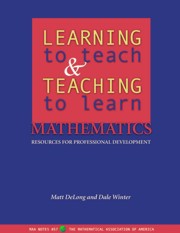Book contents
- Frontmatter
- Preface
- Contents
- 1 The Professional Development Program
- 2 How to Use this Book
- 3 An Orientation Session for the Beginning of the Semester
- 4 Making In-class Groups Work
- 5 Getting Students to Read the Textbook
- 6 Assessing and Evaluating Students' Work
- 7 Managing Homework Teams
- 8 Teaching During Office Hours
- 9 Establishing and Maintaining Control in Your Classroom
- 10 Proctoring Tests and Examinations
- 11 Teaching with Calculators and Computers
- 12 Making Lesson Plans
- 13 Strategies for Motivating Students
- 14 Dealing With Difficult Instructor-Student Situations
- 15 End-of-Semester Administration
- 16 Adapting Materials and Designing Your Own Meetings
- 17 Classroom Visits
- A Tips for Running Meetings
- B The Michigan Introductory Program
- Bibliography
5 - Getting Students to Read the Textbook
- Frontmatter
- Preface
- Contents
- 1 The Professional Development Program
- 2 How to Use this Book
- 3 An Orientation Session for the Beginning of the Semester
- 4 Making In-class Groups Work
- 5 Getting Students to Read the Textbook
- 6 Assessing and Evaluating Students' Work
- 7 Managing Homework Teams
- 8 Teaching During Office Hours
- 9 Establishing and Maintaining Control in Your Classroom
- 10 Proctoring Tests and Examinations
- 11 Teaching with Calculators and Computers
- 12 Making Lesson Plans
- 13 Strategies for Motivating Students
- 14 Dealing With Difficult Instructor-Student Situations
- 15 End-of-Semester Administration
- 16 Adapting Materials and Designing Your Own Meetings
- 17 Classroom Visits
- A Tips for Running Meetings
- B The Michigan Introductory Program
- Bibliography
Summary
Observing textbooks on introductory collegiate mathematics, and instructors who use these textbooks, one notices that there is little consensus on the role or function of a mathematics textbook. Some textbooks attempt to provide a narrative that tries to access concepts through intuition, application, and explanation. Others attempt to provide an exhaustive resource and reference. Yet others function primarily as a repository of worked examples. In addition, there are the ubiquitous tensions between rigor and accessibility, and between conceptual understanding and skill acquisition.
In our experience, many students use mathematics textbooks as little more than large collections of homework problems, templates for the “types” of problem encountered in the homework, and lists of answers (usually to the odd-numbered exercises). In some of the classes that we have taught, students clearly believed that their textbooks were dry, boring, expensive, and not at all to be read!
We both base our philosophies of the role of the textbook in a mathematics course on the assumption that such an expensive investment ought to, in fact, be read. Much more than economic considerations drive our intent to have our students read their textbooks—we feel that the textbook can and should be a vital part of the course that contributes to the learning goals that we have set for our students. Many of these specific goals are mentioned in this meeting.
Information
- Type
- Chapter
- Information
- Learning to Teach and Teaching to Learn MathematicsResources for Professional Development, pp. 55 - 64Publisher: Mathematical Association of AmericaPrint publication year: 2002
